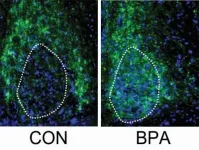Gene plays major role in brain development
Study shows that mutations of the investigated gene manifest in different patterns of inheritance
2021-06-01
(Press-News.org) When the Augustinian monk Gregor Mendel crossed white-flowering with purple-flowering pea plants in the mid-19th century, he made an interesting discovery: The offspring were all purple. He therefore called this trait dominant, while the white blossom color was recessive. The reason for this phenomenon: In peas, each gene occurs twice. One version comes from the maternal plant and the other from the paternal plant. If a pea has inherited the gene for purple flower color from one parent, but the gene for white flower color from the other, purple wins. Only when two genes for white flowers come together in the offspring plant is it white.
Humans also have genes that are inherited either dominantly or recessively. However, the case is not so clear for the mutations investigated in the study: Some of them are dominant, meaning that a mutation inherited either by the mother or by the father is sufficient for the mutation to have an impact. Others, however, are recessive. "This has also been observed sporadically with other genes, but it was still unexpected," explains Dr. Gabriel Dworschak, pediatrician at the University Children's Hospital who conducted his research at the Institute of Anatomy and the Institute of Human Genetics.
Malformations of the brain and eyes
The gene came into the focus of the researchers when they examined a girl with severe malformations of the esophagus, brain and eyes at University Hospital Bonn. A genetic analysis revealed that her Plexin-A1 gene was different from that of healthy individuals. "We then searched a database for other affected individuals with mutations in the plexin gene," explains Prof. Dr. Heiko Reutter, physician at the University Children's Hospital and staff member at the Institute of Human Genetics at the University of Bonn.
The researchers have now found a total of ten patients in this way; they come from seven families. "The affected individuals all had different parts of the Plexin-A1 gene altered," Dworschak points out. "Five of these mutations are inherited recessively; the remaining three are dominant." Further analysis helped the researchers understand why this is the case: The Plexin-A1 gene contains the building instructions for a receptor. It is located in the membrane that surrounds the nerve cells like a thin skin. Certain messenger molecules can dock onto its outer surface. This then triggers a response at the other end of the receptor that protrudes into the cell.
"If a mutation affects the outside of the receptor, it can no longer receive signals," speculates Dworschak. "However, if only one of the two Plexin-A1 versions is affected, there are enough intact receptors to compensate." Mutations on the outside are therefore probably recessive. A defect on the inside of the receptor, however, can result in a serious misregulation of the cell. It may be enough for only one version of the Plexin-A1 gene to be altered in this way to cause significant damage. "We therefore think that such mutations are dominant, and we then speak of a dominant-negative effect," says Dworschak.
Different symptoms
Overall, affected individuals show a wide range of symptoms. What they all have in common, however, is that their brain development is disrupted to varying degrees. Many of them also have malformations of the eyes and skin. "It was known that the Plexin-A1 gene is important in the growth of nerve cell extensions," Reutter explains. "Nerve sprouting plays an essential role in the development of many organs. The observed malformations in affected individuals could therefore be caused by the disrupted development of certain nerve fibers." A follow-up study at the Institute of Anatomy is currently investigating this question.
The Plexin-A1 gene performs an important function not only in us, as studies on a completely different species show. The researchers used the expertise of the working group led by Prof. Dr. Benjamin Odermatt from the Section of Neuroanatomy. The zebrafish serves as a model organism here - not only because it is easy to keep in terms of animal welfare requirements and can be bred quickly: Many of its genes are found in a similar form in humans. This includes the Plexin-A1 gene. "If we switch off this gene in zebrafish, brain development disorders similar to those in humans appear," Dworschak explains. He hopes that the results of the study will help to better understand the complex processes involved in brain development.
INFORMATION:
Participating institutions:
The study involved institutions from the USA, Turkey, India, Saudi Arabia, Pakistan, the United Kingdom, Australia, France, Canada, Italy and Germany. Dr. Jaya Punetha of Baylor College of Medicine in Texas is lead author of the study, together with Dr. Dworschak.
Publication: Gabriel C. Dworschak et al: Biallelic and monoallelic variants in PLXNA1 are implicated in a novel neurodevelopmental disorder with variable cerebral and eye anomalies; Genetics in Medicine; DOI: 10.1038/s41436-021-01196-9
[Attachments] See images for this press release:

ELSE PRESS RELEASES FROM THIS DATE:
2021-06-01
Using a Fitbit and a spy mic, scientists have discovered new insight into the behaviour of the elusive Canada lynx. A new study by researchers from McGill University, University of Alberta, and Trent University provides a first look at how miniaturized technology can open the door to remote wildlife monitoring.
"Working on one of the boreal forest's top predators, the Canada lynx, we found that two different technologies, accelerometers and audio recording devices, can be used to remotely monitor the hunting behaviour of predators, even documenting the killing of small prey," says lead author Emily Studd, a Postdoctoral Fellow under the supervision of Murray Humphries at McGill University and Stan Boutin at University ...
2021-06-01
The University of Ottawa's Positive Energy program released new survey results showing that a large segment of the Canadian public does not trust the courts to settle disputes over energy projects or climate policy. The survey was conducted by Positive Energy's official pollster, Nanos Research.
Canadians were asked: On a scale of 0 to 10, where 0 means do not trust at all and 10 means trust completely, how much do you trust the courts to settle disputes over government decisions on energy projects? They were asked the same question for climate policy. The results are very similar. Only one in three Canadians trust the courts to settle disputes over energy projects or climate policy (answering between 7 and 10: 31% for energy, 30% for ...
2021-06-01
Machine learning, when used in climate science builds an actual understanding of the climate system, according to a study published in the journal Chaos by Manuel Santos Gutiérrez and Valerio Lucarini, University of Reading, UK, Mickäel Chekroun, the Weizmann Institute, Israel and Michael Ghil, Ecole Normale Supérieure, Paris, France. This means we can trust machine learning and further its applications in climate science, say the authors. The study is part of the European Horizon 2020 TiPES project on tipping points in the Earth system. TiPES is administered from the University of Copenhagen, Denmark.
Man or ...
2021-06-01
Humans are exposed to a bath of chemicals every day. They are in the beds where we sleep, the cars that we drive and the kitchens we use to feed our families. With thousands of chemicals floating around in our environment, exposure to any number is practically unavoidable. Through the work of researchers like Dr. Deborah Kurrasch, PhD, the implications of many of these chemicals are being thoroughly explored.
"Manufacturers follow standards set by regulatory bodies, it's not up to the manufacturers to prove the chemicals in consumer products are safe," says Kurrasch, a researcher in the University of Calgary's Hotchkiss Brain ...
2021-06-01
Right-wing voices set out powerful but misleading arguments to justify inaction by the Trump administration during the COVID-19 pandemic, according to a new study of the rhetoric used by high-level government officials and influential commentators in the US during the first half of 2020.
In a study published in the DeGruyter journal Open Anthropological Research, Professor Martha Lincoln of San Francisco State University examined how public officials openly pushed for people to accept widespread illness and death from the virus by adopting a tone that suggested premature death was normal and the scale of death acceptable in the grander ...
2021-06-01
RUDN mathematician and his colleagues from China, Egypt, Saudi Arabia, United Kingdom, and Qatar have developed an algorithm allowing the distribution of computing tasks between the IoT devices and the cloud in an optimal way. As a result, the power and time costs are reduced by about three times. The study was published in the Big Data.
With the development of technologies and devices, Internet of Things (IoT) applications require more and more computing power. The amount of data that the IoT devices need to process can be so large that it is reasonable to migrate computing to the cloud. Cloud computing provides flexible data processing and storage capabilities. But Computation offloading, meaning transferring of the resource-intensive processes ...
2021-06-01
A DTU research team consisting of Malgorzata Gosia Pierchala, Firoz Babu Kadumundi, and Mehdi Mehrali from #TeamBioEngine headed by Alireza Dolatshahi-Pirouz, have developed a new material - CareGum - that among other things has potential for monitoring motor impairment associated with neurological disorders such as Parkinson's.
A green material with many properties
The CareGum property portfolio is incredibly broad with feats such as skin-like softness, it is stretchable up to 30,000 % and has self-healing capacities reminiscent of that of natural tissues. It is printable, moldable, and electrically conductive. Notably, the electrical conductivity enables the material to respond to external stimuli ...
2021-06-01
Oncotarget published "STAT3 induces the expression of GLI1 in chronic lymphocytic leukemia cells" which reported that what induces GLI1 expression in GLI1-unmutated CLL cells is unknown.
Because signal transducer and activator of transcription 3 is constitutively activated in CLL cells and sequence analysis detected putative STAT3-binding sites in the GLI1 gene promoter, the authors hypothesized that STAT3 induces the expression of GLI1.
Western immunoblotting detected GLI1 in CLL cells from 7 of 7 patients, flow cytometry analysis confirmed that CD19 /CD5 CLL cells co-express GLI1 and confocal microscopy showed co-localization of GLI1 and phosphorylated STAT3. Chromatin immunoprecipitation showed ...
2021-06-01
A series of autopsies performed in an infectious disease hospital in the Brazilian Amazon reveals that infections by the Histoplasma fungus are a major cause of death in people with HIV. The study, led by Barcelona Institute for Global Health (ISGlobal), an institution supported by "la Caixa" Foundation, in collaboration with a team in Manaus, highlights the need of implementing sensitive methods to detect these infections in Histoplasma-endemic regions.
Histoplasmosis is a lung infection caused by inhalation of spores from a fungus (Histoplasma), and is frequent in some areas of the US, Africa, and Latin America.
In the majority of individuals with a functional immune system, the infection causes mild symptoms. However, in people who are immuno-compromised, such ...
2021-06-01
Scientists at Kyoto University's Institute for Integrated Cell-Material Sciences (iCeMS) in Japan have developed a technology that produces high-resolution simulations of one of the basic units of our genomes, called the nucleosome. Their findings were published in the journal Nature Protocols and should help improve understanding of how changes in nucleosome folding influence the inner workings of genes.
Nucleosomes are the basic structural units of DNA packaging inside the nucleus. They are formed of DNA wrapped around a small number of histone proteins. Nucleosomes move around inside the nucleus, folding and unfolding, changing their orientations, and moving closer together or further apart. These movements affect the accessibility of various molecules to DNA, determining ...
LAST 30 PRESS RELEASES:
[Press-News.org] Gene plays major role in brain development
Study shows that mutations of the investigated gene manifest in different patterns of inheritance








